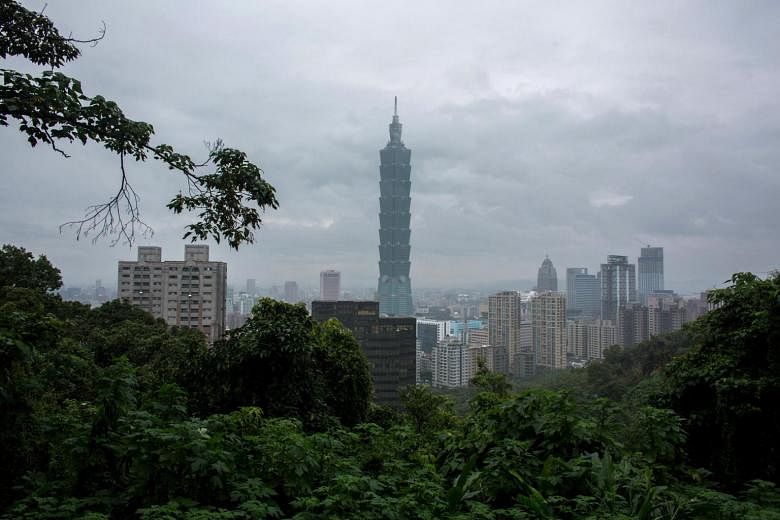TAIPEI (NYTIMES) - The Taipei 101 building, which was for five years the world's tallest, has towered over the Taiwanese capital for more than a decade.
Very much a build-it-and-they-will-come venture, the 1,666.7-foot tower was erected in one of the city's least built-up areas, Xinyi District, as a symbol of a modern and ambitious Taiwan.
Thirteen years later, Xinyi is Taipei's centre for finance, business, offices and shopping. And in a sign that Taipei 101 has accomplished its mission of attraction, other skyscrapers are finally rising next door, altering the skyline of an otherwise surprisingly low-rise city.
The first of the new buildings, the 48-storey, 892-foot Nan Shan Plaza, is scheduled for completion at the end of this year. Already topped out, the high-rise, and its neighbours to come, will stand roughly half the height of Taipei 101, which will remain the district's dominant edifice for the foreseeable future.
The project takes its name from Nan Shan Life Insurance. Nan Shan won rights to a 50-year lease of the former site of Taipei World Trade Centre's Hall 2 with a US$894 million (S$1.2 billion) bid. To date, Nan Shan has spent more than US$1.6 billion on the project, the company said.
"Xinyi" is a Chinese word roughly analogous to "good faith", which shaped the project's design goal of expressing thanks to Taiwan. The main building, an elongated triangle, is intended to represent two hands pressed together as a gesture of thanks and prayer for Taiwan's continued good fortune, said project architect Yasuhiro Sube, of the Tokyo-based Mitsubishi Jisho Sekkei.
Mr Sube said he also had chess pieces in mind as he drew up the building, with Taipei 101 as king and Nan Shan Plaza as queen.
"The biggest challenge was already having Taipei 101 next door - if we were going to build its queen, then we would have to harmonise our design to do so," Mr Sube said. "Additionally there was the concept of giving thanks, which required us to consider how to use the external form of the building to convey this."
At street level, Nan Shan Plaza complements its surroundings. It bookends the pedestrian- and bike-friendly retail zone stretching between it and Taipei 101, which, just a stone's throw to its west, has its own thriving shopping centre, including Taiwan's first Apple store.
A block north is the Taipei City Hall subway station, which is dominated by the Breeze Songgao and Shin Kong Mitsukoshi mall complexes, brimming with global and domestic restaurants and lifestyle brands.
Given Nan Shan Plaza's prime location, rents inside are not cheap by Taipei standards, but remain a fraction of the cost of prime office space in Shanghai, Singapore or Hong Kong. Depending on the floor and view, rent can run between US$3.50 and US$4.20 per square foot.
Rather than work with an agent, Nan Shan Life is handling rentals itself.
"We believe the office building is best suited for national or regional headquarters," said Mr Jason Chen, assistant vice-president of Nan Shan's real estate department. "We're currently in talks with several financial institutions, IT companies and global professional services companies."
Mr Chen and his colleagues are tasked with filling Nan Shan Plaza's 570,000 sq ft of commercial space, including a mall at its base and a dining area on the 46th through 48th floors.
There is also 1.13 million sq ft of office space between the sixth and 43rd floors. Tenants will begin moving in during the third quarter of 2018, he said.
Mr Andrew Huang, associate director at the Taipei office of the real estate consultancy Knight Frank, which is not involved in leasing at Nan Shan Plaza, said Xinyi should benefit from the new supply of office space.
"Many people are concerned that there will be an oversupply problem, due to the addition of so much new supply, including a million square feet of office space," Mr Huang said. "But Nan Shan has been preleasing since last year, and their rental prices are not as high as we'd expected."
The Nan Shan team's initial success in signing the Executive Centre, a serviced office provider, and an international accountancy would help attract more tenants, he added.
If all goes well, the next addition to the Xinyi skyline will be the 51-storey, 919-foot Taipei Sky Tower just north of Nan Shan Plaza, and the 52-storey, 873.8-foot Fubon Group Xinyi Headquarters to its northeast.
The Taipei Sky Tower, designed by Mr Antonio Citterrio Patricia Viel, is planned for completion in 2020. The project, developed by the Taipei-based real estate private equity investment company Riant Capital, will feature two hotels, both of which are expected to be international brands.
The Fubon Group Xinyi Headquarters design is a collaboration by the Renzo Piano Building Workshop - the firm behind The New York Times Building and the Whitney Museum in New York, and the Shard in London - and the Taiwanese architect Kris Yao's firm, Kris Yao Artech, which designed the Southern Branch of Taiwan's National Palace Museum.
The building's namesake is a prominent financial services group that also owns one of the country's four pro baseball teams, the Fubon Guardians.
The arrival of Taipei Sky Tower and Fubon Xinyi Headquarters is unlikely to hurt the office space market, Mr Huang said. Fubon, for instance, is moving many of its operations from older buildings in nearby Neihu District.
There is also another reason Mr Huang is sanguine about the future of the central business district in Xinyi. He said: "Right now, rents in Taipei are extremely cheap."
Taipei 101's most expensive units, for example, rent for about US$3.70 per sq ft.
"Compared with Hong Kong, Shanghai, Beijing or Singapore, Taipei rents don't even compare," he said.

